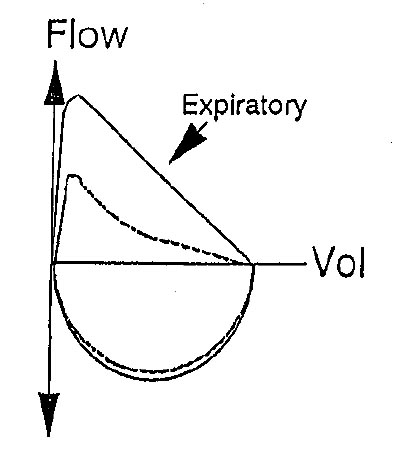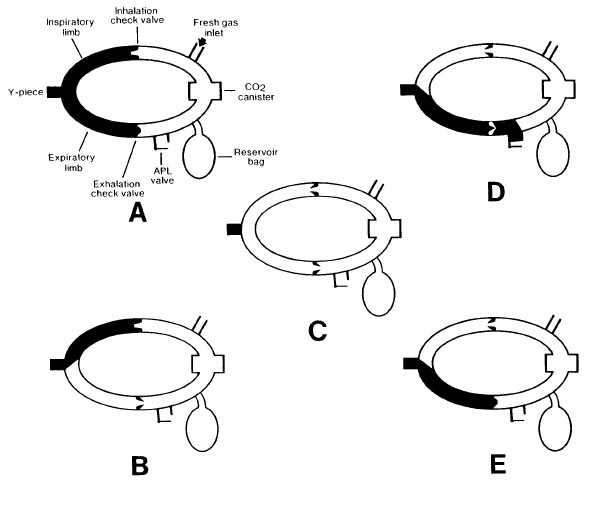10 Random Questions
A 54-year-old man receives 25 ml of a 50% alcohol and 0.25% bupivacaine solution for celiac plexus block. During the next 20 minutes, blood pressure decreases from 130/75 mmHg to 85/55 mmHg. Which of the following is the most likely cause?
- (A) Intravascular injection
- (B) Retroperitoneal hemorrhage
- (C) Splanchnic vasodilation
- (D) Subarachnoid blockade
- (E) Tension pneumothorax
A 35-year-old woman with systemic lupus erythematosus is admitted to the critical care unit following sudden onset of severe chest pain. Examination shows tachycardia, hypotension, pulmonary edema, and a blowing systolic murmur in the left parasternal region. The most appropriate management is
- (A) aerosol administration of terbutaline
- (B) intravenous infusion of phenylephrine and nitroglycerin
- (C) intravenous infusion of esmolol
- (D) intravenous infusion of epinephrine and nitroprusside
- (E) volume loading with lactated Ringer's solution
The illustration depicts flow-volume loops for the same person at two different times in his life. Which of the following is indicated by the dotted loop?

- (A) Bronchial tumor
- (B) Chronic asthmatic bronchitis
- (C) Morbid obesity
- (D) Paralysis of a vocal cord
- (E) Subglottic stenosis
A 75-year-old man in the PACU complains of severe pain following thoracotomy. Respiratory rate is 30/min; arterial blood gas values are PaO2 70 mmHg, PaCO2 56 mmHg, and pH 7.28 at an FiO2 of 0.6. The patient has a thoracic epidural catheter and received epidural morphine 2 mg 45 minutes earlier. Which of the following is the most appropriate immediate management?
- (A) Intravenous administration of naloxone
- (B) Epidural administration of additional morphine
- (C) Epidural administration of 0.125% bupivacaine
- (D) Epidural administration of fentanyl
- (E) Intubation of the trachea
Which of the following statements regarding fetal heart rate patterns is true?
- (A) Early decelerations suggest umbilical cord compression
- (B) Fetal heart rates between 160 and 180 bpm are normal
- (C) Fetal heart rate unaffected by uterine contraction suggests fetal well-being
- (D) Late decelerations indicate inadequate uteroplacental perfusion
- (E) Variable decelerations indicate need for urgent delivery
A 24-year-old woman requires anesthesia for emergency repair of open fractures of the tibia and fibula. She used cocaine two hours ago. Blood pressure is 170/110 mmHg. Each of the following is useful in managing the hypertension EXCEPT
- (A) hydralazine
- (B) labetalol
- (C) nitroprusside
- (D) phentolamine
- (E) propranolol
Which of the following shaded areas most accurately represents the dead space of a properly functioning circle system?

On routine inspection of an anesthesia machine, the nitrous oxide E cylinder pressure is 360 psi. This indicates that the
- (A) pressure in the cylinder is 16 atm
- (B) cylinder contains no liquid nitrous oxide
- (C) cylinder is half full
- (D) cylinder contains enough nitrous oxide for one hour of anesthesia at a flow rate of 3 L/min
- (E) reducing valve is malfunctioning
A patient has an anterior neck injury, hoarseness, labored respirations, subcutaneous emphysema, and laryngeal crepitus following a motor vehicle accident. Which of the following is the best method of securing the airway in this situation?
- (A) Blind nasotracheal intubation
- (B) Lightwand intubation
- (C) Retrograde wire-guided intubation
- (D) Tracheostomy
- (E) Transtracheal jet ventilation
During ligation of a patent ductus arteriosus, a newborn infant receives a total gas flow of 5 L/min through a nonheated Jackson-Rees system. Operating room temperature is maintained at 30°C. The primary cause of a rapid decrease in rectal temperature from 36.8°C to 35°C is
- (A) absence of the central temperature control mechanism
- (B) conductive heat loss
- (C) convective heat loss
- (D) evaporative heat loss
- (E) radiant heat loss